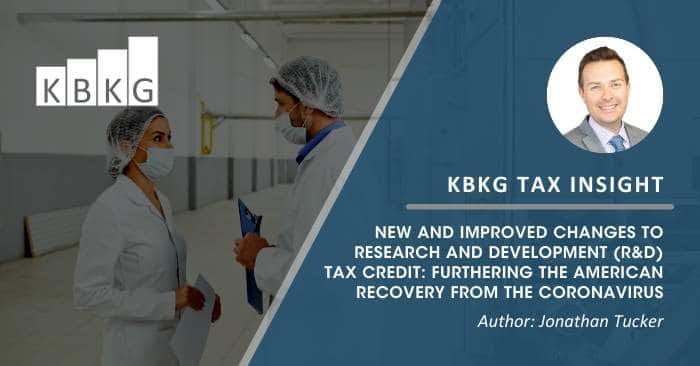Senator Chris Coons of Delaware recently introduced legislation (S. 3593) called “Furthering Our Recovery With American Research & Development Act” (“FORWARD”), which makes changes to and expands Internal Revenue Code Section 41: Credit for Increasing Research Activities (“IRC 41”). Applying these modifications to the existing law could allow companies that invest in the research and development of new or improved products, processes, formulas, computer software, techniques, or inventions quicker ways to monetize their research and development (“R&D”) tax credit. Additionally, it could expand activities that would qualify for the research and development tax credit.
Under FORWARD, the definition of a qualified R&D expense is expanded to include employee training expenses, in addition to the existing in-house research expenses and contract research expenses. The term employee training expenses means any wages paid or incurred to an employee in connection with training for the employee to perform qualified services, which includes engaging in qualified research or engaging in the direct supervision or direct support of research activities that constitute qualified research. Training does not include wages paid or incurred in connection with general employer training. This new provision allows taxpayers to expand the amount of qualified R&D expenses they include in their R&D tax credit computation.
A key provision of IRC 41 includes the ability of Qualified Small Businesses (“QSB”) to utilize its R&D tax credit against the FICA portion of their payroll tax liability. Currently, the definition of a QSB is an entity that has gross receipts for the current taxable year of less than $5,000,000, and the entity did not have gross receipts for any tax year before the 5-tax-year period ending with the current credit year (e.g., in the 2020 taxable year, an entity may not have had any gross receipts in 2015 or prior). FORWARD changes the definition of a QSB to be an entity that has gross receipts for the current taxable year of less than $20,000,000 and such entity did not have gross receipts in excess of $25,000 for any taxable year before the 8-tax-year period ending with the current credit year (e.g., in the 2020 taxable year, an entity may not have greater than $25,000 of gross receipts in 2012 or prior).
KBKG Insight: These changes drastically expand the number of taxpayers eligible to utilize the R&D tax credit against payroll taxes. Currently, QSB’s that deposit their seed money in savings accounts and earn a de minimis amount of interest on those amounts may not qualify for the payroll tax credit if the interest was earned more than five years ago. The FORWARD act would address this issue by disregarding interest amounts received that are less than $25,000.
In addition to the change in definition for QSBs, FORWARD increases the cap of R&D tax credits taxpayers can elect to utilize against payroll tax from $250,000 per year to $1,000,000 per year. Further, FORWARD eliminates the limitations of C-Corps to use its R&D tax credit against income tax first, before applying it to payroll tax.
The expansion of the definition of qualified R&D expense and changes to the definition of QSB are effective for taxable years beginning after December 31, 2019.
FORWARD adds a new subsection to IRC 41, 41(i), called “Special Rules for Certain High-Benefit Research Activities,” which is effective for taxable years beginning after December 31, 2020. This subsection applies to certain collaborative research and research by United States manufacturers.
For qualified United States manufacturers, there is a bonus rate increase in the R&D tax credit rates. A qualified United States manufacture means a taxpayer who has domestic production gross receipts, which are more than 50 percent of total gross receipts. In the event a United States manufacturer has greater than 50% of domestic gross receipts, the bonus R&D tax credit rates (and total R&D tax credit rates) are as follows:
| Domestic Gross Receipts Percentage | Regular Credit Bonus Rate (Total Rate) | Alternative Simplified Credit (“ASC”) Bonus Rate (Total Rate) | ASC if no qualified research expenses in any of the 3 prior years Bonus Rate (Total Rate) |
|---|---|---|---|
| >50% but <60% | 1% (21%) | 0.7% (14.7%) | 0.3% (6.3%) |
| >60% but <70% | 2% (22%) | 1.4% (15.4%) | 0.6% (6.6%) |
| >70% but <80% | 3% (23%) | 2.1% (16.1%) | 0.9% (6.9%) |
| >80% but <90% | 4% (24%) | 2.8% (16.8%) | 1.2% (7.2%) |
| >90% | 5% (25%) | 3.5% (17.5%) | 1.5% (7.5%) |
For certain collaborative research, there is an increase in the R&D tax credit rates. The regular credit method rate will become 25%; the ASC method rate will become 17.5%, and; the ASC method rate, if there are no qualified research expenses in any of the 3 prior years, will become 7.5%. Taxpayers may be eligible for these increased R&D tax credit rates if they collaborate with one or more entities, including educational institutions, certain scientific research organizations, tax-exempt scientific organizations, a Federal laboratory, or a qualified research consortium. This provision only applies if each entity involved in the collaboration provides or performs more than ½ of its pro-rata share of the work hours for the research.
These are exciting times for research and development, and companies should take advantage of these opportunities to reduce taxes that are due or paid. Reach out to a KBKG R&D specialist to see if you may qualify for the R&D tax credit Kevin Zolriasatain; Jonathan Tucker; or Paul McVoy.
Author: Jonathan Tucker
About the Author
 Jonathan Tucker – Director
Jonathan Tucker – Director
Southeast
Jonathan Tucker is a Director for KBKG’s R&D Tax Credit Consulting practice. Based in Atlanta, GA, Jon has over fourteen years of experience providing federal business tax advisory services to clients in various industries including technology, manufacturing (including heavy, light, and paper and pulp), transportation, healthcare, retail and consumer products, hospitality, media and entertainment, financial, and other professional services industries. » Full Bio


